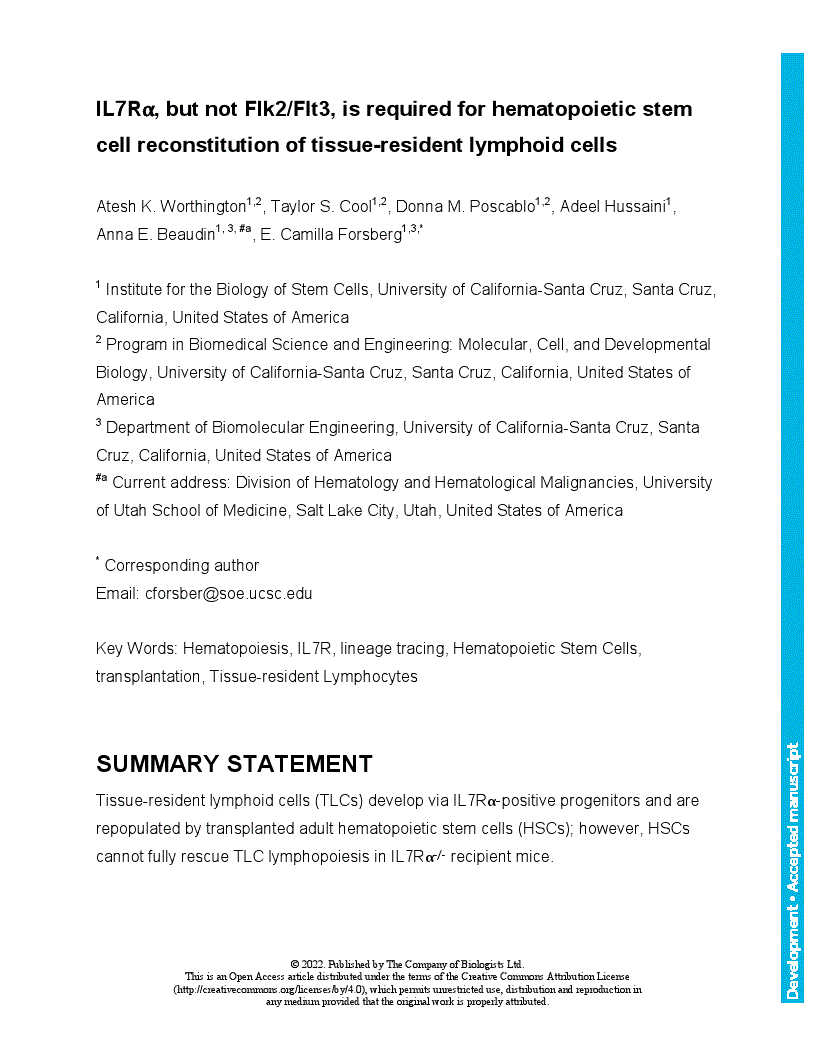Tissue-resident lymphoid cells (TLCs) span the spectrum of innate-to-adaptive immune function. Unlike traditional, circulating lymphocytes that are continuously generated from hematopoietic stem cells (HSCs), many TLCs are of fetal origin and poorly generated from adult HSCs. Here, we sought to further understand murine TLC development and the roles of Flk2 and IL7R⍺, two cytokine receptors with known function in traditional lymphopoiesis. Using Flk2- and Il7r-Cre lineage tracing, we found that peritoneal B1a cells, splenic marginal zone B (MZB) cells, lung ILC2s and regulatory T cells (Tregs) were highly labeled. Despite high labeling, loss of Flk2 minimally affected the generation of these cells. In contrast, loss of IL7R⍺, or combined deletion of Flk2 and IL7R⍺, dramatically reduced the number of B1a cells, MZBs, ILC2s, and Tregs both in situ and upon transplantation, indicating an intrinsic and essential role for IL7Rα. Surprisingly, reciprocal transplants of WT HSCs showed that an IL7Rα−/- environment selectively impaired reconstitution of TLCs when compared to TLC numbers in situ. Taken together, our data defined Flk2- and IL7Rα-positive TLC differentiation paths, and revealed functional roles of Flk2 and IL7Rα in TLC establishment.
IL7R⍺, but not Flk2/Flt3, is required for hematopoietic stem cell reconstitution of tissue-resident lymphoid cells
Present address: Division of Hematology and Hematological Malignancies, University of Utah School of Medicine, Salt Lake City, Utah, USA
- Award Group:
- Funder(s): National Institute of Diabetes and Digestive and Kidney Diseases
- Award Id(s): R01DK100917
- Funder(s):
- Award Group:
- Funder(s): American Asthma Foundation
- Award Id(s): NA
- Funder(s):
- Award Group:
- Funder(s): National Heart, Lung, and Blood Institute
- Award Id(s): F31HL151199
- Funder(s):
- Award Group:
- Funder(s): American Heart Association
- Award Id(s): NA
- Funder(s):
- Award Group:
- Funder(s): Howard Hughes Medical Institute
- Award Id(s): NA
- Funder(s):
- Award Group:
- Funder(s): California Institute for Regenerative Medicine
- Award Id(s): CL1-00506
- Funder(s):
- Award Group:
- Funder(s): Tobacco-Related Disease Research Program
- Award Id(s): NA
- Funder(s):
Currently Viewing Accepted Manuscript - Newer Version Available
Atesh K. Worthington, Taylor S. Cool, Donna M. Poscablo, Adeel Hussaini, Anna E. Beaudin, E. Camilla Forsberg; IL7R⍺, but not Flk2/Flt3, is required for hematopoietic stem cell reconstitution of tissue-resident lymphoid cells. Development 2022; dev.200139. doi: https://doi.org/10.1242/dev.200139
Download citation file:
Advertisement
Call for papers: Uncovering Developmental Diversity

Development invites you to submit your latest research to our upcoming special issue: Uncovering Developmental Diversity. This issue will be coordinated by our academic Editor Cassandra Extavour (Harvard University, USA) alongside two Guest Editors: Liam Dolan (Gregor Mendel Institute of Molecular Plant Biology, Austria) and Karen Sears (University of California Los Angeles, USA).
Choose Development in 2024

In this Editorial, Development Editor-in-Chief James Briscoe and Executive Editor Katherine Brown explain how you support your community by publishing in Development and how the journal champions serious science, community connections and progressive publishing.
Journal Meeting: From Stem Cells to Human Development

Register now for the 2024 Development Journal Meeting From Stem Cells to Human Development. Early-bird registration deadline: 3 May. Abstract submission deadline: 21 June.
Pluripotency of a founding field: rebranding developmental biology

This collaborative Perspective, the result of a workshop held in 2023, proposes a set of community actions to increase the visibility of the developmental biology field. The authors make recommendations for new funding streams, frameworks for collaborations and mechanisms by which members of the community can promote themselves and their research.
Read & Publish Open Access publishing: what authors say

We have had great feedback from authors who have benefitted from our Read & Publish agreement with their institution and have been able to publish Open Access with us without paying an APC. Read what they had to say.



